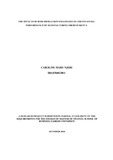| dc.description.abstract | Kenya’s manufacturing sector is going through a major transition period largely due to the
structural reform process, which the Kenya Government has been implementing since the mideighties
with a view to improving the economic and social environment of the country.
Manufacturing firms fall under the umbrella of Kenya Association of Manufacturers (KAM)
(2002). Kenya association of manufacturers posits that removal of price controls, foreign
exchange controls and introduction of investment incentives have, however, not resulted in major
changes in the overall economy, and in particular, they have not improved the manufacturing
performance. The impact of risk on the business environment deals with the level of
understanding of cause effect relationships. The impact of a given state of events may cause
uncertainty for a firm, industry or the general business environment. By incorporating risk
management into manufacturing firms’ operations, manufacturing firms are better equipped to
exploit their resources, thereby enabling their organizations to transform an expenditure activity
into an activity that can yield a positive return .Several studies relating to risk mitigation have
previously been conducted in Kenya. However there lacks evidence so far of a study conducted
in Kenya to investigate the effects of risk mitigation strategies on the financial performance of
manufacturing firms in Kenya. Therefore, it is against this backdrop that this study sought to fill
this gap by answering the following question; what are the effects of risk mitigation strategies on
the financial performance of manufacturing firms in Kenya. The study adopted a descriptive
approach in trying focus on large manufacturing firms in Nairobi .The population of the study in
this research was of large scale manufacturing companies that are based in Nairobi .The study
therefore involved 46 large manufacturing companies in Nairobi. Table 3.1 shows how 46 firms
that form the sample size was arrived at. The study used primary data that was collected
through a self-administered questionnaire that consisted of both open and closed ended
questions that was designed to elicit specific responses for qualitative and quantitative analysis
respectively.The research deployed both qualitative and quantitative methods The study found
out that most frequent occurring risk is Production (failures in internal systems, processes and
people, or from external factors) .Further respondents indicated that Economic (associated with
commercial and business performance) risk; occupational risk (health and safety of employees)
and operational risk, (fraud, oversight failure, lack of control, and managerial limitations, human
error or omission, design mistakes unsafe behavior, employee practice risks, and sabotage)
occurs frequently. The study concludes that most frequent occurring risk is Production (failures
in internal systems, processes and people, or from external factors).The study recommends
proper risk mitigation planning | en_US |

